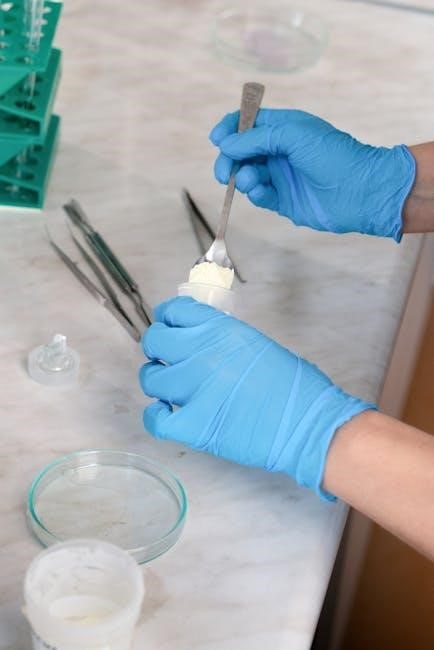Insulation resistance testing verifies the integrity and safety of electrical insulation. It ensures minimal current leakage, crucial for safe and efficient operation. Download the free PDF guide for detailed procedures and best practices.
1.1 What is Insulation Resistance Testing?
Insulation resistance testing measures the resistance of electrical insulation using a high DC voltage. It identifies if insulation is performing effectively and safely. A higher resistance indicates better insulation quality. This non-destructive test helps verify the integrity of electrical systems, ensuring minimal current leakage. Free PDF guides provide detailed methods for conducting these tests, making it easier to understand and perform insulation resistance evaluations accurately. The process is essential for maintaining electrical safety and efficiency in various applications, from cables to industrial wiring systems.
1.2 Importance of Insulation Resistance Testing
Insulation resistance testing is crucial for ensuring electrical safety and system reliability. It helps detect insulation failures, preventing potential hazards like short circuits and fires. By identifying deterioration early, it reduces maintenance costs and extends equipment lifespan. Regular testing ensures compliance with safety standards, protecting both personnel and equipment. Free PDF guides offer step-by-step procedures, making it easier to implement effective testing routines and maintain high safety standards in electrical installations. This practice is vital for both domestic and industrial wiring systems to ensure optimal performance and safety.
1.3 Brief Overview of the Test Procedure
Insulation resistance testing involves using a megohmmeter to measure resistance between conductive parts. A DC voltage is applied, typically 500V or 1000V, to assess insulation quality. Higher resistance values indicate better insulation. The procedure includes preparing equipment, setting up the environment, connecting leads, applying voltage, and recording results. Factors like temperature and humidity can affect outcomes. The test is non-destructive and essential for ensuring safety and compliance. For detailed steps, download the free PDF guide, which provides a comprehensive overview of the process and its significance in electrical systems.

Purpose and Scope of the Insulation Resistance Test
The test ensures electrical safety, identifies insulation deterioration, and verifies compliance with standards. It helps prevent failures and guarantees reliable operation of electrical systems and equipment.
2.1 Ensuring Electrical Safety
Insulation resistance testing is crucial for ensuring electrical safety by identifying potential risks such as insulation breakdown. It helps detect weaknesses that could lead to shocks or fires, safeguarding people and equipment. By verifying insulation integrity, the test prevents electrical hazards and ensures compliance with safety standards, promoting a secure operating environment for electrical systems and devices. Regular testing is essential to maintain safety and reliability in industrial and domestic settings alike. This step is fundamental in upholding electrical safety protocols and preventing unforeseen dangers.
2.2 Identifying Insulation Deterioration
Insulation resistance testing plays a vital role in detecting insulation deterioration, which can lead to electrical failures. Over time, insulation may degrade due to factors like moisture, temperature, or aging, reducing its resistance. Low resistance readings indicate potential issues, allowing early intervention to prevent faults. This test helps identify weak points in the insulation system, ensuring timely repairs and maintaining the integrity of electrical equipment. Regular testing is essential for predicting and addressing insulation degradation, thereby enhancing system reliability and longevity.
2.3 Compliance with Electrical Standards
Insulation resistance testing ensures compliance with electrical safety standards, such as those set by IEC, IEEE, or NFPA. These standards outline minimum resistance values for safe operation, helping prevent electrical hazards. By conducting regular tests, professionals verify that insulation meets required specifications, ensuring system reliability. Compliance also guarantees adherence to industry best practices, reducing liability risks. Following standardized procedures ensures accurate and consistent results, aligning with regulatory requirements. This makes insulation testing a critical step in maintaining electrical system safety and performance.

Tools and Equipment Required for the Test
A megohmmeter, test leads, and safety gear are essential. Ensure the equipment is calibrated and suitable for the voltage range specified in the test procedure.
3.1 Megohmmeter (Insulation Resistance Tester)
The megohmmeter is a critical tool for measuring insulation resistance. It operates at high voltage (typically 500V or 1000V DC) to ensure accurate readings. Modern models feature digital displays, automatic range selection, and data storage capabilities. Ensure the device is calibrated and suitable for the voltage level of the equipment being tested. Portability and durability are key factors, as the tester is often used in field conditions. Always verify the device’s CAT rating to ensure it matches the system’s voltage for safe operation.
3.2 Test Leads and Probes
Test leads and probes are essential for connecting the megohmmeter to the equipment under test. High-quality leads ensure accurate readings and minimize measurement errors. They should be insulated to prevent short circuits and designed for durability. Probes with sharp tips are ideal for piercing insulation, while alligator clips provide secure connections to terminals. Regularly inspect leads for damage or wear, as faulty connections can lead to incorrect results. Always use leads rated for the test voltage to maintain safety and reliability during the insulation resistance test procedure.
3.3 Safety Gear and Protective Equipment
Safety gear is crucial during insulation resistance testing to protect against electrical hazards. High-voltage gloves, rated for the test voltage, prevent electrical shocks. Safety glasses or goggles shield eyes from debris. Insulating mats or anti-static wrist straps ensure proper grounding and prevent accidental discharge. A first aid kit should always be nearby. Proper protective equipment minimizes risks and ensures compliance with electrical safety standards. Always wear appropriate gear to safeguard against potential electrical hazards during the test procedure.
Step-by-Step Test Procedure
The step-by-step procedure involves preparing equipment, setting up the environment, connecting leads, applying test voltage, and recording results to ensure accuracy and safety, following test standards.
4.1 Preparing the Equipment for Testing
Begin by ensuring the megohmmeter is calibrated and functioning correctly. Verify all test leads, probes, and connections are in good condition. Select the appropriate test voltage based on the equipment’s voltage rating, typically 500V or 1000V DC. Gather safety gear, including insulated gloves and goggles, to protect against electrical hazards. Review the test procedure from a reliable insulation resistance test procedure PDF to ensure compliance with standards. Organize the equipment neatly to avoid tangling of leads during testing. Ensure the device under test is de-energized and discharged to prevent accidents.
4.2 Setting Up the Test Environment
Ensure the test area is clean, dry, and free from electrical interference. Maintain a stable ambient temperature and humidity level, as specified in the insulation resistance test procedure PDF. Ground the equipment under test to ensure safety and accurate readings. Isolate the system from other circuits to prevent external electrical noise. Verify that all surfaces are clear of contaminants and moisture, which can skew results. Properly position the megohmmeter and leads to minimize movement during testing. Ensure the environment is well-ventilated and free from direct sunlight or heat sources.
4.3 Connecting the Test Leads
Connect the test leads to the equipment as specified in the insulation resistance test procedure PDF. Ensure the leads are securely attached to the designated terminals to maintain proper contact. Use the correct lead for positive and negative terminals to avoid polarity issues. Verify that all connections are tight and free from corrosion or damage. If using auxiliary leads, connect them according to the manufacturer’s instructions. Always discharge capacitors before connecting to prevent sudden voltage surges. Double-check the connections to ensure accuracy and safety during testing. Follow the guide for specific connection diagrams and recommendations.
4.4 Applying the Test Voltage
Apply the test voltage as specified in the insulation resistance test procedure PDF. Set the megohmmeter to the required voltage (typically 500V or 1000V DC). Ensure the circuit is de-energized and all safety precautions are in place. Press the test button to apply the voltage across the insulation. Allow the voltage to stabilize for the recommended time, usually a few seconds, before taking readings. Avoid touching live terminals during this process. The test voltage should not be applied to live or energized circuits to prevent accidents or equipment damage.
4.5 Reading and Recording the Results
After applying the test voltage, read the insulation resistance value directly from the megohmmeter’s display. Ensure the reading stabilizes before recording. Note the resistance value in ohms, along with the test voltage and ambient temperature. Accurate documentation is crucial for compliance and future reference. Compare results with previous records to identify trends or deterioration. Store the data securely, as it may be required for audits or maintenance reports. Always refer to the insulation resistance test procedure PDF for specific recording guidelines and Pass/Fail criteria.

Understanding Insulation Resistance Test Results
Interpret resistance values to assess insulation quality. Higher resistance indicates better insulation. Refer to the insulation resistance test procedure PDF for Pass/Fail criteria and detailed analysis guidance.
5.1 Interpreting the Resistance Values
Interpreting resistance values is crucial for assessing insulation integrity. High resistance indicates good insulation, while low values suggest deterioration. The insulation resistance test procedure PDF provides detailed criteria for Pass/Fail determination. Typically, a resistance of 1 MΩ or higher is considered acceptable. Lower values may indicate moisture, damage, or aging. Always refer to the specific standards outlined in the PDF for accurate interpretation. This ensures reliable and consistent test results, helping to maintain electrical safety and system performance over time.
5.2 Determining Pass/Fail Criteria
Determining Pass/Fail criteria involves comparing test results to predefined standards. The insulation resistance test procedure PDF outlines specific thresholds, often based on industry standards like IEEE or IEC. Typically, a resistance reading of 1 MΩ or higher is considered a Pass, while lower values indicate failure. Factors like equipment type, voltage, and age may influence these criteria; Always consult the PDF guide for precise thresholds, ensuring compliance with safety and performance requirements. This step is critical for accurate test evaluation and decision-making.
5.3 Factors Affecting Test Results
Several factors can influence insulation resistance test results. Environmental conditions like temperature and humidity play a significant role, as moisture can lower resistance. The age and condition of the insulation also impact outcomes, with degraded materials showing lower values. Contaminants, such as dirt or oil, can compromise results. Additionally, the test voltage level and the integrity of test leads can affect accuracy. Understanding these factors is crucial for interpreting results correctly, as outlined in the insulation resistance test procedure PDF.

Safety Precautions and Best Practices
Safety precautions involve wearing PPE, de-energizing circuits, following manufacturer guidelines, ensuring proper lead connections, and calibrating equipment. Always adhere to international safety standards.
6.1 Ensuring Personal Safety
Ensuring personal safety during insulation resistance testing involves wearing proper PPE, including insulated gloves and safety glasses. Always de-energize circuits and verify voltage absence with a multimeter. Use test leads with secure connections to prevent accidental shocks. Maintain a safe working environment, free from moisture and conductive materials. Follow all manufacturer guidelines and lockout/tagout procedures. Be aware of your surroundings to avoid slips or trips. Never touch live equipment or test leads during the procedure. Emergency equipment should be readily available. Adhere strictly to safety standards to minimize risks and ensure a safe testing process.
6.2 Avoiding Common Testing Mistakes
Avoiding common testing mistakes requires careful preparation and attention to detail. Ensure the equipment is properly calibrated and suitable for the voltage level. Incorrect test voltage settings can lead to inaccurate results. Always disconnect and discharge capacitors before testing. Avoid using damaged test leads, as they can introduce errors. Environmental factors like humidity or temperature fluctuations should be considered. Never test circuits under load or with live components. Follow the test procedure step-by-step to minimize errors. Properly interpreting results is crucial for accurate analysis. Regularly review and update testing techniques to maintain reliability and consistency.
6.3 Calibrating the Testing Equipment
Calibrating insulation resistance testers ensures accurate and reliable test results. Always follow the manufacturer’s calibration procedures, which may include using reference standards or built-in calibration features. Regular calibration prevents measurement errors and guarantees compliance with industry standards. Use certified reference resistors to verify the tester’s accuracy. Keep calibration records for traceability and compliance purposes. Perform calibration in a stable environment to avoid interference. Proper calibration ensures the equipment functions correctly, providing trustworthy insulation resistance measurements. Regular checks help maintain the device’s performance over time.

Common Applications of Insulation Resistance Testing
Insulation resistance testing is vital for ensuring electrical safety and reliability in various systems. It is commonly applied to electrical cables, motors, generators, and domestic/industrial wiring.
7.1 Testing Electrical Cables
Insulation resistance testing is crucial for assessing the condition of electrical cables. It helps detect issues like moisture ingress, physical damage, or insulation degradation. By applying a high DC voltage (typically 500V to 1000V) using a megohmmeter, technicians can measure resistance levels. High resistance indicates healthy insulation, while low values suggest faults. This test ensures cable reliability, prevents unexpected failures, and guarantees safe operation in industrial and domestic settings. Regular testing is essential for maintaining electrical integrity and compliance with safety standards.
7.2 Inspecting Motors and Generators
Insulation resistance testing is vital for inspecting motors and generators to ensure their electrical integrity. This test helps identify insulation deterioration in windings, which can lead to equipment failure. By applying a high voltage using a megohmmeter, technicians can assess the insulation’s condition. High resistance indicates good insulation, while low values suggest issues like moisture or contamination. Regular testing prevents unexpected shutdowns and ensures operational efficiency. It is essential for maintaining the reliability and longevity of motor and generator systems in industrial applications.
7.3 Evaluating Domestic and Industrial Wiring
Insulation resistance testing is crucial for evaluating domestic and industrial wiring systems to ensure electrical safety and efficiency. It helps detect issues like wear, moisture, or aging in insulation, which can lead to short circuits or fires. By applying a test voltage, technicians can measure resistance levels, identifying potential faults. Regular testing prevents electrical hazards and ensures compliance with safety standards. This procedure is essential for maintaining reliable power distribution in both residential and industrial environments, avoiding costly repairs and downtime.

Downloading the Insulation Resistance Test Procedure PDF
Downloading the insulation resistance test procedure PDF provides a comprehensive guide for conducting safe and accurate tests. It includes step-by-step instructions, safety protocols, and interpretation of results.
8.1 Sources for Free PDF Downloads
Several reputable sources offer free insulation resistance test procedure PDFs. Official websites like the International Electrotechnical Commission (IEC) and the National Electrical Manufacturers Association (NEMA) provide standardized guides. Additionally, university websites, electrical engineering portals, and safety organizations often share detailed procedures. These resources ensure access to accurate, up-to-date methods for performing insulation resistance tests safely and effectively. Always verify the credibility of the source to ensure compliance with industry standards and safety protocols.
- Official standards organizations
- Electrical engineering websites
- University resources
- Safety and testing associations
Download from trusted platforms to avoid outdated or incorrect information.
8.2 Key Features of the PDF Guide
The insulation resistance test procedure PDF guide typically includes detailed step-by-step instructions, safety protocols, and visual diagrams. It covers equipment setup, test voltage applications, and result interpretation. The guide also outlines pass/fail criteria, troubleshooting tips, and compliance with international standards. Many PDFs include appendices with formulas and reference materials, ensuring comprehensive understanding. These features make the guide an essential resource for both novice and experienced technicians, providing clarity and confidence in performing accurate insulation resistance tests.
- Step-by-step testing procedures
- Safety guidelines and precautions
- Visual aids and diagrams
- Compliance with industry standards
8.3 Benefits of Using a Standardized Procedure
A standardized insulation resistance test procedure ensures consistency, accuracy, and reliability in results. It minimizes human error by following established protocols, ensuring compliance with safety and industry standards. Technicians can perform tests efficiently, reducing downtime and costs. Standardization also facilitates easier documentation and comparison of results over time, aiding in long-term maintenance planning. This approach ensures that testing is repeatable and verifiable, maintaining electrical system integrity and safety.
- Consistent test results and accuracy
- Compliance with industry standards
- Reduced risk of human error
- Efficient testing and documentation

Troubleshooting Insulation Resistance Test Issues
Common issues include low insulation resistance, equipment malfunctions, and environmental interference. Identifying root causes ensures accurate results and reliable electrical system performance. Key issues often involve improper connections, moisture, or faulty devices.
- Low insulation resistance due to moisture or aging
- Malfunctioning test equipment requiring calibration
- Environmental factors like humidity affecting readings
9.1 Identifying Low Insulation Resistance
Low insulation resistance indicates potential issues like moisture, contamination, or aging. It can lead to electrical failures and safety hazards. Causes include poor installation, environmental factors, or material degradation. Inspect for signs of wear, corrosion, or moisture infiltration. Use a megohmmeter to measure resistance levels, comparing them to manufacturer standards. Addressing low resistance early prevents further deterioration and ensures system reliability. Regular maintenance and testing are crucial for identifying such issues promptly. Always follow safety guidelines when investigating and resolving low insulation resistance problems.
9.2 Diagnosing Equipment Malfunctions
Diagnosing equipment malfunctions during insulation resistance testing involves checking the megohmmeter, test leads, and connections. Common issues include faulty or uncalibrated devices, damaged cables, or incorrect voltage settings. Ensure all components are in good condition and properly connected. Perform a self-test on the megohmmeter to verify its accuracy. If malfunctions persist, consult the manufacturer’s guidelines or seek professional assistance. Regular calibration and maintenance of equipment are essential for accurate test results and reliable performance. Addressing these issues ensures the integrity of the insulation resistance testing process.
9.3 Resolving Environmental Interference
Environmental interference, such as humidity, temperature fluctuations, or electromagnetic fields, can impact insulation resistance test accuracy. To resolve this, ensure the test environment is controlled, with minimal moisture and stable temperatures. Use shielded cables to reduce electromagnetic interference and verify that all connections are secure and dry. Additionally, check the grounding of equipment to avoid noise interference. If issues persist, consult the megohmmeter’s calibration guidelines or the manufacturer’s recommendations for troubleshooting. Proper environmental control ensures reliable and precise test results.
Insulation resistance testing is crucial for ensuring electrical safety and system reliability. Regular testing helps prevent failures and hazards, promoting a secure and efficient electrical environment.
10.1 Summarizing the Importance of the Test
Insulation resistance testing is crucial for ensuring electrical safety, preventing hazards, and maintaining system reliability. It helps detect insulation deterioration early, avoiding unexpected outages and reducing fire risks. Regular testing ensures compliance with safety standards, protecting people and equipment. By identifying faults before they escalate, it minimizes downtime and extends equipment lifespan. This procedure is essential for maintaining operational integrity and ensuring long-term electrical system performance. Regular insulation testing is a proactive approach to safeguarding lives and assets in both domestic and industrial settings.
10.2 Encouraging Regular Testing Practices
Regular insulation resistance testing is vital for maintaining electrical system reliability and safety. It helps prevent unexpected equipment failures and ensures compliance with safety standards. Encourage technicians to adopt routine testing practices, as consistent monitoring can detect potential issues early. By making it a priority, organizations can reduce downtime, extend equipment lifespan, and safeguard lives and assets. Regular testing fosters a proactive maintenance culture, ensuring systems operate efficiently and securely over time.
- Prevents unexpected failures
- Ensures safety and compliance
- Extends equipment lifespan
10.3 Final Tips for Effective Insulation Testing
For effective insulation testing, always adhere to the guidelines outlined in the insulation resistance test procedure PDF. Use a calibrated megohmmeter and ensure proper test lead connections. Apply the recommended test voltage and allow sufficient time for accurate readings. Environmental factors like humidity and temperature can impact results, so consider these during testing. Refer to the PDF guide for detailed steps and troubleshooting tips; Regular calibration of equipment and proper documentation of results are essential for reliable outcomes.
- Use calibrated equipment
- Follow PDF guidelines
- Document results accurately

Frequently Asked Questions (FAQs)
- What is the best source for a free insulation resistance test procedure PDF?
- How often should insulation testing be performed?
- Can I download the PDF guide for personal use?
Download the PDF guide for detailed insights and step-by-step instructions on insulation resistance testing.
11.1 What is the recommended test voltage?
The recommended test voltage for insulation resistance testing typically ranges between 500V and 1000V DC, depending on the equipment and standards. Higher voltages provide better accuracy in measuring insulation resistance. Always refer to the specific standards or manufacturer guidelines for the correct voltage to ensure safety and compliance. Using the wrong voltage may lead to inaccurate results or equipment damage. For detailed guidance, download the insulation resistance test procedure PDF, which outlines voltage specifications for various applications.
11.2 How often should insulation testing be performed?
Insulation testing frequency depends on the equipment type, usage, and environmental conditions. Typically, testing is recommended annually for most electrical systems. However, in harsh environments or for critical systems, testing may be required every 6 months. Always follow the manufacturer’s guidelines or industry standards. For high-voltage equipment or systems in hazardous locations, more frequent testing is essential. Refer to the insulation resistance test procedure PDF for specific recommendations tailored to your equipment and application.
11.3 Can insulation resistance testing be done on live circuits?
Insulation resistance testing on live circuits is not recommended due to safety risks. Live circuits carry high voltage and current, which can damage equipment and pose severe safety hazards. Testing should only be performed on de-energized circuits to ensure technician safety and accurate results. Always disconnect power sources before conducting the test, as specified in the insulation resistance test procedure PDF. This ensures compliance with safety standards and prevents potential accidents or equipment damage.

Additional Resources and References
Access official standards from IEEE and IEC for comprehensive guidelines. Refer to manufacturer specifications for equipment-specific details. Explore academic papers and forums for additional insights.
12.1 Recommended Reading Materials
Download the IEEE Standard 1188 for insulation testing guidelines. Explore eBooks on insulation resistance testing from Google Books. Visit ResearchGate for free access to academic papers on the topic. Check out IEC 60990 for test voltage specifications. Look for “Insulation Resistance Testing Handbook” on online libraries. Refer to NETA standards for detailed test procedures. Find free PDFs of “Electrical Insulation Testing” on educational websites. These resources provide in-depth knowledge and practical insights for conducting accurate insulation resistance tests.
12.2 Online Courses and Training Videos
Explore online courses on Coursera and Udemy for detailed insulation testing training. YouTube offers free tutorials on insulation resistance testing procedures. Platforms like Skillshare provide hands-on workshops. Websites like edX host courses from leading universities. These resources cover test preparation, equipment usage, and result interpretation. Training videos on LinkedIn Learning and Electrical Engineering portals also offer practical insights. Enroll in these courses to enhance your understanding and skills in conducting insulation resistance tests effectively and safely.
12.3 Manufacturer Guidelines and Specifications
Consult manufacturer guidelines for insulation resistance testing, such as those from Fluke, Megger, and Hioki. These documents provide detailed specifications, test voltage recommendations, and acceptable resistance values. Visit the official websites of these manufacturers to download free PDF resources. Their guidelines ensure compliance with industry standards and guarantee accurate test results. Always follow the manufacturer’s instructions for equipment usage and interpretation of data to maintain safety and reliability in your insulation resistance testing procedures.
